The history of amplified sound for live music did not evolve from a high demand for fidelity, and this should be approached with 'in context'. It is essential to understand the history behind sound for live production to go beyond the separate mono PA trend the entertainment industry trapped itself in.
Sports are the largest of spectacle events. The collective energy and roar of crowds in large reverberant stadiums and auditoriums, drives the adrenaline of excitement similar to addiction. The majority of audiences go to see (not listen to) sport and live musical productions including opera as spectacle events. Traditionally, entrepreneurs see lighting and image as important, not sound fidelity. Budgets for sound are often limited to within 10% of total production cost.
Not all performers express interest in how they are heard by an audience. This they believe should be managed by others. However, stage monitoring is understandably a performers prime concern. The separate mono PA of limited fidelity has become the simplest cost alternative for audiences to hear live music productions.
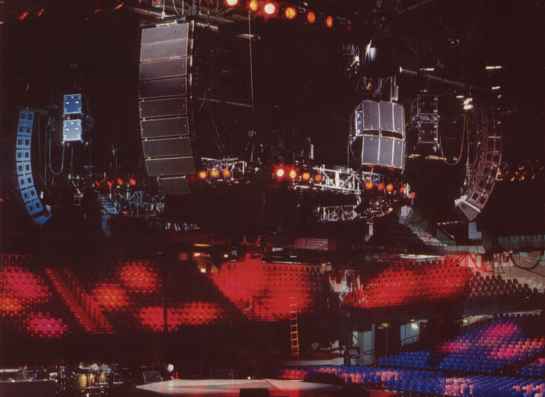
Above is an example of technology reaching the limit of what can be technically achieved from a line-source PA system, for sport and live music productions.
The speaker stacks are spread around the stadium or auditorium as close as possible to the audience. Technical emphasis is not on dynamic fidelity or realism but for the whole audience to hear sound almost at the same level through out the venue. In its own direction, this latest technology (line-array) has been an astounding technical achievement, enabling sound to be heard equivalently throughout large reverberant environments.
But live music productions are pre-mixed and compressed, often only heard in mono from each nearest speaker stack. The result for music, bears little or no resemblance to how the production would sound directly, up close or on the stage. The sound system acts as a barrier separating the performance from the audience. Sometimes the audience only see the performance on large video projection.
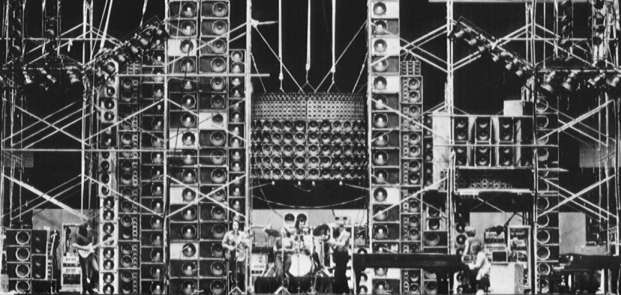
Above is a pic of the 1970s Greatful Dead sound system that represents the alternate (opposite) principal of each instrument and voice being amplified and heard from separate stage sound systems. The audience experience startling dynamic clarity, similar to being up close or on stage with the musicians.
In the early 1970s there were a handful of innovative sound companies including Lenard Audio that were developing variations of this principle . This direction was not adopted by the entertainment industry because it was seen as too difficult to implement. It is essential to understand the history behind sound for live music production, to go beyond the separate mono PA trend the entertainment industry trapped itself in.
Historical Context
In each generation a percentage of rebellious youth culture is symbolised by aggressive, loud, harsh distorted noise. Rock music evolved from Blues, the music of the streets. Most musos' of the 50s were poor. PAs and guitar amps were made to a budget. Not all technical principles of sound system design were well thought out.
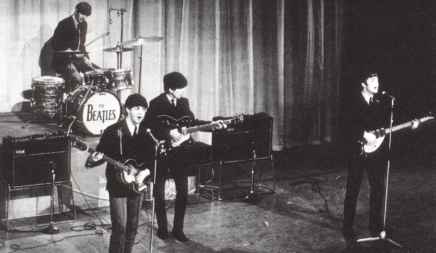
In 1964 The Beatles toured the world using their Vox 30 Watt instrument amps. They often used small house PAs consisting of 12in speakers in columns driven by 100 Watt amps (if they were lucky). The screaming audience completely drowned them out. In many cases the band was not heard at all. They never did concert tours again. This sent a strong message to entrepreneurs that sound quality had no effect on audience attendance. Prior to this period bands only had small amps and simple lighting often with only a single spot. Instruments were the main drive and vocals were separate.
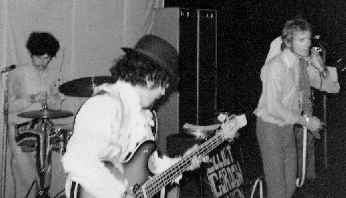
The majority of PAs in the early 60s consisted of columns of 12in speakers. (seen in the background of the pic on the right) Bands often did 3 gigs a night, traveling in unregistered Kombis or transit vans. This restricted PAs to two 4 x 12in columns, similar to the size of instrument amps. Few bands operated as an efficient business. Large horn-loaded PA systems were economically out of reach.
The Transition
Then came the transition period of the PA which began to dominate as the main system with both instruments and voices adapted within it. But the result was a compressed sound, devoid of dynamic expression, fidelity and realism. PA's were at an impasse. For a PA to be effective it had to be at least 4 times the scale of the instrument amps and fully active to achieve fidelity. Many bands believed that venues should assume responsibility for sound but this did not evolve.
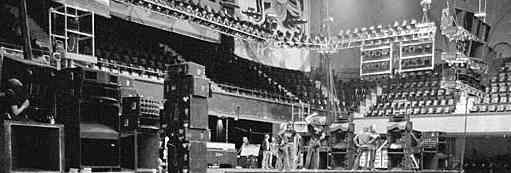
Many early sound system manufacturers, were conservative from a previous generation of the 40s and 50s, influenced by religious, country or jazz music. In the early 60s, many manufacturers were horrified by the sex-crazed, drug-driven, anti-war/religious, rock-musos', who drove their sound systems into hard distortion. When these sound systems were first designed it was inconceivable they would be used this way. The technical limitations of these systems characterised their sound enabling them to distort easily, exactly what many 60s rock musos' wanted.
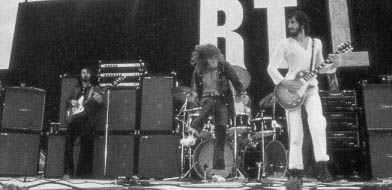
The ironic humour, was that some manufacturers reacted by making warranties void, if sound systems were driven at full power. Other (well known brand) manufacturers threatened to cut off retailers, who sold their sound systems to bands that played 'music of the devil'. The parody of this historical contradiction has been rewritten, to fit mythical beliefs, that brilliant designers, created these systems for what 60s and 70s rock bands' wanted.
Many hard rock and pop bands were musically unprofessional, driven by stage theatrics, copying 'heavy rock and metal' trends in the styles of the Stones, Sex Pistols, Black Sabbath, Led Zeppelin etc. The drug image of many bands assisted their promotion with full support of record companies and media exposure. This later evolved into branches of rap and techno. This drug culture also dominated the new emerging live sound re-enforcement industry.

Most concert sound systems consisted of horizontal clusters of ugly black boxes (adapted from cinemas) that produced harsh, distorted, unintelligible sound. This image also included the entourage of multi set of keys, stoned, roadie sound engineers. Through ignorance they placed speakers facing directly forward, against side walls, which increased room reflections, lobeing, and comb-filter distortion. They have gigantic mixing consuls with racks of effects which they place in the middle of audiences with desk-lights on themselves. There favourite effect is to add compression to everything. Many roadies' wanted to be musos' and therefore make their favoured instrument or singer loudest and turned off who they dislike. The bands constantly complain about their on-stage monitoring, but take little interest in how they are heard by the audience.

By the late 60s, fusion music including a % of pop, rock and R&B, performed with a high level of music skill also became popular. Santana, Frank Zappa, Chick Corea, Herby Handcock, Eagles, Yes and the Motown label etc, to name a few. This music inspired the development of full fidelity, large-scale active PAs. But music of high technical skill (including classical) has limited support from media and record companies. Considered too complex for mainstream audience enjoyment.
By the late 70s the world had changed. The era of the 60s which created free love and the greatest diversity of music ever known had come to a close. The 80s became known as the era of entrepreneurial greed. A plethora of questionable audio recording engineering schools flourished. Media editorial became advertorial, particularly in audio journal's. Many major brand name sound systems were made cheap as possible but became expensive to purchase. Brand names became marketed as having magical powers (especially cables). Model-number junkies dominated the industry.
Ceiling Clusters

By the 80s, moving sound systems from the floor to the ceiling became the trend. This gave extra floor space for staging. Reverberation and echoes from walls and ceiling is multiplied if the speaker systems are incorrectly placed which most were - and still are. Organising speakers into semi-cylindrical vertical clusters has the potential to reduce some problems previously described. Fidelity improves if sound appears from a single source. But there is a maximum size clusters can be arranged, before distortion becomes excessive.
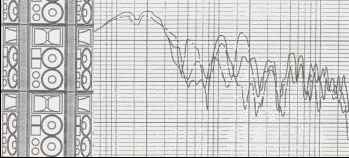
Above is a typical performance graph of popular (passive) speaker cabinets used in clusters. Some expensive (active) speaker cabinets, were designed for cluster arrangements, minimising lobeing between speakers. Some clusters were spread through-out the auditorium, others were placed in centre position above stage (above right). On stage instrument amps became smaller and fold-back monitoring increased in complexity. The modern trend was for the audience not to hear sound form the stage. All sound dominates from the ceiling cluster systems. The PA now behaves as a barrier, separating audience from performance.
Most performances are mixed in mono. The irresponsible trend of using excessive compression for recording also dominated live music. Compression changes the character of voices and instruments away from sounding natural. Without hearing direct sound from the stage (comparison) it is difficult, if not impossible to know if a performance is mimed. In some events entire orchestras mime.
The development of full fidelity, large-scale active PAs, inspired by fusion music in the late 60s early 70s, was left incomplete. It became too difficult to innovate new designs in what had become a technically illiterate industry, dominated by commercial interest promoting hard rock, techno, and vacuous teeny pop. The emerging IT industry consumed the best technical people. The live sound re-enforcement industry was left to flounder for the next 20 years. Loud harsh distorted sound remained the primary symbol of live music.
Line Source Systems

1990s. The application of line-source systems allowed entrepreneurs to market to larger and larger events. Originally line-source speaker systems were confined to small columns, seen in churches, gymnasiums, schools etc. Application limited to announcements and background music.
Line-source sound systems for large venues had been understood since the 50s. But the limited efficiency of a large line-source compared to the higher efficiency of a well designed full exponential horn system was not acceptable at that time. Especially for cinemas.
Why the change?
(1) Large power amps became readily available, and cheap.
(2) Technical problems of rigging and component alignment, were solved.
(3) Passive social acceptance over 2 generations of listening to limited fidelity.
The theoretical advantage of a line-source system is that the whole audience can hear the sound equally. Sound appears to remain at a similar level as the distance from the line-source increases. The inverse square law is reduced and horizontal directivity improved. Line-source systems are the best solution for large difficult reverberant environments (sport stadiums etc). But many line source systems are being marketed as the best solution for every imaginable application. They are not the best solution in excellent acoustical environments, where fidelity is the major requirement. These reasons are explained on the previous page 'Horn Systems'.
I visited my old aunt in a small outback country town. It was their annual show. During the day was the competition for the blue ribbons for the best farm animals and local produce. Most exciting was the apple pie competition, which my aunt lost to a 16-year-old girl. At night were the sideshows, ferris wheels, and dodgem cars. The distorted noise from all the speakers brought tears to my eyes and transported me back to my childhood.
My first trip to a city was to a large department store. We crowded into a lift, where a little man sat on a stool controlling a leaver. There was silence except for the vomitus melody 'Never on Sunday'. My claustrophobic aunt trembled and held onto me. But to be trapped, unable to reach the speaker is what obsessed me. Later we went to a matinee 'Casablanca'. The projector whirred in the background, the sprocket slipped and the sound periodically went out of sync, but Bogey always had control.
Many years later at a rock festival, a group was smashing their guitars on stage and setting them alight. The lead singer was screaming into a microphone and the drummer was hacking at the speakers with an axe. A stoned (multiple set of keys) roadie mixed from the middle of the audience with a desk-light on himself, surrounded by groupies. The crowd went wild with excitement.
In each generation the rebelliousness of youth culture is symbolised by loud harsh distorted noise. I pray there must be a place in heaven where all these past experiences can remain intact and not need to be repeated.


